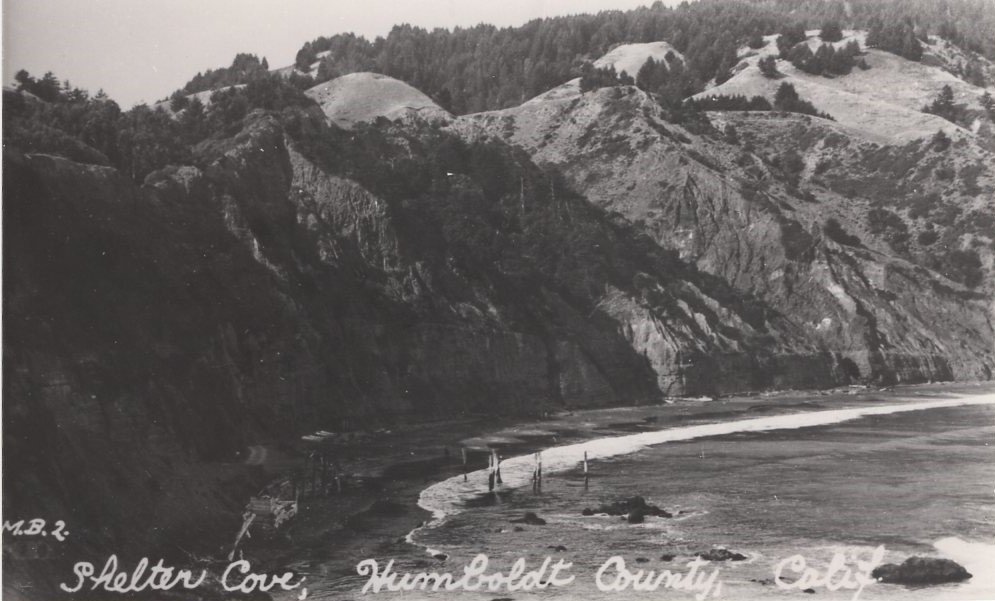Shelter Cove
Postcard of Shelter Cove, Phegley Collection
In some ways, the name for this small coastal community says it all.
For centuries, it sheltered settlements of the Sinkyone tribe, who hunted in its hills, fished in its ocean and tidepools, and traded its marine salt with inland tribes. Area shell mounds still testify to their long occupation.
The Spanish exploring north along California’s coast stopped there to take on fresh water from its springs, and the Russians exploring south along the coast hunted otters there. All noted the desirable shelter provided by the bay – as long as the weather was from the north, though weather from the unprotected south was another matter. Scores of later shipwrecks that dot the area testify to this.
When Euro-Americans settled there in the 1850s, bringing cattle to graze on the lush grasslands, confrontations with the Sinkyone soon led to the indigenous people being slaughtered or displaced.
As our county began developing in the Eureka area, Shelter Cove became an important shipping stop. Ships anchored in the bay, and goods were ferried to and from the beach. Household goods, groceries and barrels of whiskey came ashore while hides, fruit and butter were shipped out. Transportation inland was handled by mule train over steep zig-zag trails.
To further accommodate this trade, a 960-foot-long pier was built in 1885, though its construction and maintenance continued to be a challenge. Eucalyptus trees with wood more impervious to aquatic rot, were planted for use in building the pier and bulkhead shoring up the bluff.
The 1880s also saw the popularity of Shelter Cove as a vacation spot for adventurous residents of the San Francisco and Humboldt Bay areas. Hotels, campgrounds and sports fishing flourished, encouraging the growth of a larger settlement with stores, a blacksmith and residences.
The more solid foundation for the area’s prosperity was an abundance of tanbark trees. The tannic acid leached from their peeled bark was valued for tanning leather. San Francisco and local entrepreneurs were soon involved. Some sap was rendered locally, some was brought in barrels from inland Briceland, and chunks of bark were also shipped out for processing elsewhere.
By the 1920s, area tanbark trees were largely gone, and the local industry floundered. But fishing for sport or commerce was taking its place. Salmon, abalone and other catches were processed locally or shipped off to San Francisco. The Prohibition Era also added to the economy as Shelter Cove became a valued “rum runner” port.
In the 1930s, maintenance of the pier was abandoned and commercial fishing declined. However, during World War II, a new shot to the economy came when the US Coast Guard located a Coastal Patrol there – remodeling a barn for patrol horses, building a kennel and converting the old hotel into barracks.
After the War, three brothers by the name of Machi returned to the area where they had spent childhood summers, and built up the sports fishing business. An airstrip and houses were constructed.
For a while in the 1960s, there was a flurry of land speculation and development plans including a projected resort, golf course and over 4000 residences. These plans faced some local opposition and many worried over the high estimated cost of improving an access road that had not changed much since mule train days. 1972 derailed things further when an air crash killed several prospective buyers, and the establishment of the California Coastal Commission restricted development in the larger Lost Coast area. And, although speculation continues, the economy of tourism from hikers and those seeking a wilderness experience has introduced a new element into Shelter Cove’s story.
That story and those of other Humboldt communities is preserved for further study in the archives of the Humboldt County Historical Society.

